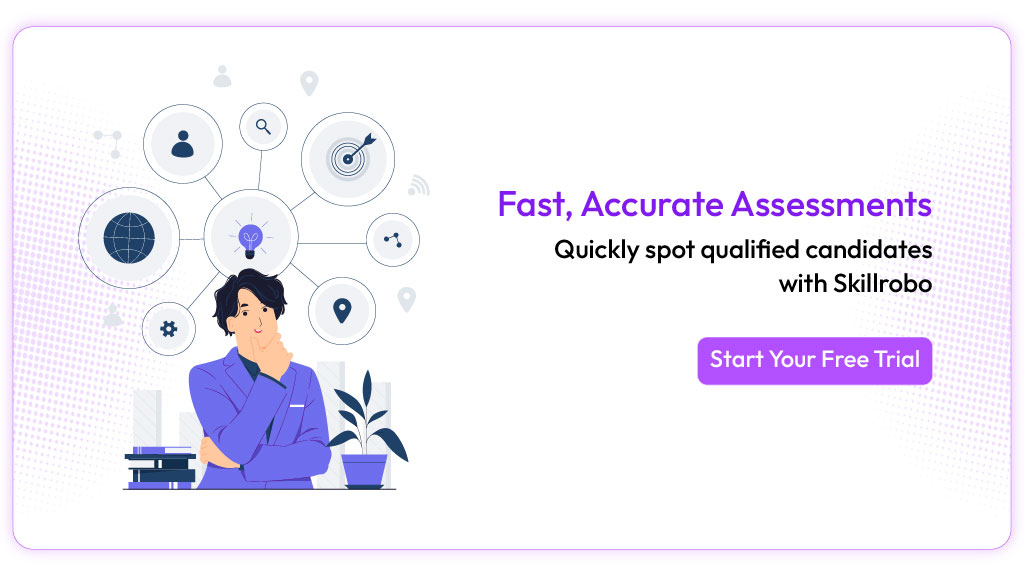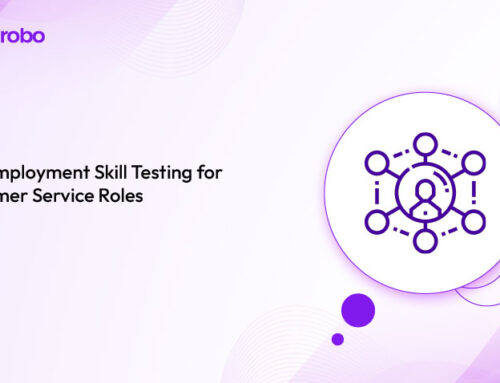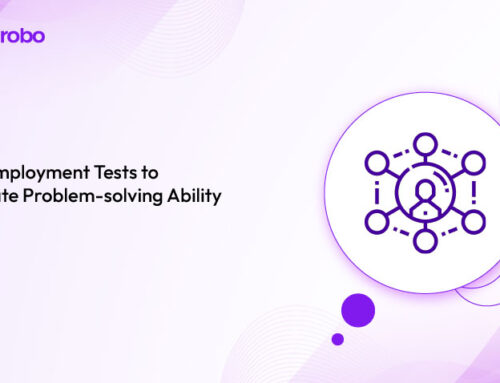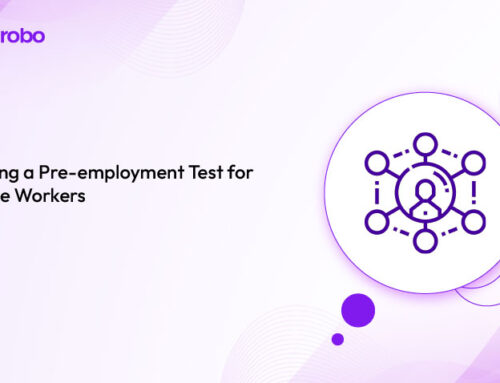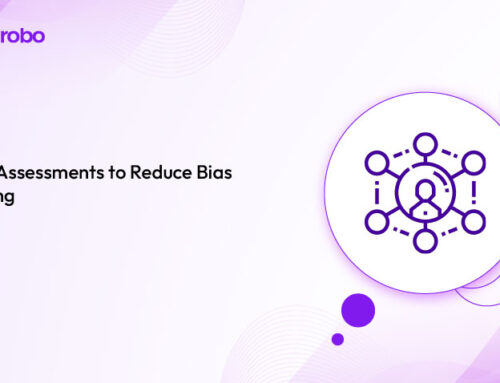
Key Takeaways
- Pre-employment skill assessments identify job-ready candidates, enhancing hiring accuracy and ensuring strong team performance from day one.
- Combine technical, cognitive, and behavioral tests to build a comprehensive candidate profile, revealing both immediate fit and growth potential.
- AI-driven tools like Skillrobo, craft relevant questions and deliver fair evaluations, streamlining the design process efficiently.
- Real-time analytics provide instant insights into candidate skills, speeding up decisions and prioritizing top talent effectively.
Why Good Assessment Design Wins Hires
Hiring is a high-stakes game—choose wrong, and you’re stuck with costly misfits who drag down the team. Pre-employment skill assessments cut through resume fluff, testing real abilities like coding, planning, or customer charm to find hires who deliver. A badly designed test, though, can push away top talent or let weak candidates slip through, wasting time and resources.
A 2023 SHRM study shows that 65% of recruiters land better hires when tests align with job needs. Crafting sharp assessments means knowing the role inside out, using smart tools, and keeping things fair. Let’s explore how to build tests that spot stars and set your team up to shine.
1. Set Clear Goals for Your Test
A test without a clear purpose is like cooking without a recipe—you might end up with a mess. Defining goals ties your assessment to the job’s heart, ensuring you test skills that matter, like data analysis for accountants or empathy for support staff. Clear objectives keep candidates focused and HR confident, avoiding irrelevant questions or overwhelmed applicants. Here’s how to lay a rock-solid foundation for your assessment.
Pinpoint Must-Have Skills
Start by dissecting the job—what skills are non-negotiable? A marketer needs campaign creativity; a warehouse worker needs inventory precision. Talk to team leads to list core tasks, like drafting reports or troubleshooting tech. This focus builds a test that measures what drives success, ensuring hires hit the ground running. Skip this, and you risk testing fluff that doesn’t predict performance. Our candidate assessment tools guide shares ways to zero in on key competencies fast.
Define Success Standards
What does “good enough” look like? Set clear benchmarks—like coding a function in 15 minutes or handling a client call without escalation. These standards act as a ruler, letting you measure candidates consistently. For a sales role, you might expect 80% accuracy in negotiation scenarios. Without this, you’re left guessing who’s up to par. Clear markers streamline decisions, ensuring only qualified hires move forward.
Sync with Company Goals
Your test should reflect what the company’s chasing—say, growth or stellar service. If innovation’s your edge, test problem-solving for engineers; if retention’s key, check empathy for HR. A logistics firm might prioritize speed in sorting tasks to cut costs. Linking tests to goals makes hires strategic assets, not just warm bodies. Check our streamlining recruitment post for tips on aligning hiring with vision.
Match Experience Levels
One size doesn’t fit all—test depth must match the role’s seniority. A junior analyst might tackle basic Excel; a senior one faces forecasting models. Over-testing newbies scares them off; under-testing pros miss their edge. For a lead designer, include strategy questions, not just sketching tasks. Tailoring ensures relevance, catching the right talent without frustration. This step keeps your test practical and candidate-friendly.
Stay Legal and Fair
Bias can creep in, landing you in hot water. Goals should focus on job skills—like scheduling for admins—not unrelated traits like cultural knowledge. Compliant tests dodge legal risks and level the playing field for all applicants. A sloppy approach might favor one group unfairly, skewing hires. The Eliminating bias guide shows how to keep assessments clean and equitable.
Engage Stakeholders Early
Don’t go solo—pull in managers or role experts to shape goals. A nurse’s input on patient-care tests ensures you’re not missing bedside manner. Their insights ground your objectives in reality, catching nuances HR might overlook, like stress handling for chefs. Early buy-in also boosts team trust in the process. Collaboration sharpens focus, making your test a true talent filter.
2. Build Questions That Reveal Talent
Questions are the soul of your test—flub them, and you’ll misread candidates’ skills. Sharp ones mimic real work, showing who can handle the gig. A vague or off-base question clouds judgment; a clear one lights up ability. For a call center, test conflict resolution, not random trivia. Here’s how to craft questions that uncover the best hires.
Mirror Real Job Tasks
Design tasks candidates will face—like debugging for coders or budgeting for accountants. A retail test might simulate a busy checkout, showing who stays calm. Real-world scenarios prove who’s job-ready, not just book-smart. A hiring manager once missed a gem because the test ignored practical skills—don’t repeat that. Our cloud-based testing post highlights ways to tie tasks to daily work.
Mix-Up Question Types
One format won’t cut it. Use multiple-choice for quick checks (e.g., software shortcuts), open-ended for reasoning (e.g., solving a team dispute), and hands-on tasks (e.g., draft a proposal). A manager’s test might quiz policies, and then ask for a priority plan. This mix catches technical know-how and soft skills, giving you a full picture. Variety keeps candidates engaged, showing their range.
Write Clear Instructions
Fuzzy prompts ruin results. “Make something better” flops; “Fix this SQL query error” hits the mark. Clear questions let candidates shine, not stumble over bad wording. A vague task once tanked a star hire’s score—don’t let that happen. Precise instructions ensure fairness, and judging skills, not decoding ability. Clarity builds trust, making your test reliable for all.
Scale Difficulty Wisely
Start easy—say, basic formulas—then ramp up to complex models for finance roles. Adaptive questions tweak difficulty based on answers, keeping tests fair for newbies and pros. This approach catches potential without boring experts or stumping beginners. A one-size-fits-all test risks missing both ends. Scaling smartly, like pacing a race, keeps everyone in the game and reveals true depth.
Check with Experts
Bring in pros to vet questions. A coder can confirm a programming task’s relevance; a marketer can sharpen ad pitch scenarios. Their feedback ensures tests match current job needs, not outdated skills. Without this, you might test old tech nobody uses. Expert input boosts credibility, ensuring your assessment filters for the right talent every time.
3. Tap Technology for Smarter Tests
Tech turns clunky tests into smooth talent-spotters. AI crafts precise questions, proctoring locks in honesty, and analytics speed up picks. A 2023 Deloitte study found that 60% of tech-savvy recruiters hire stronger fits. The tools on Skillrobo make designing tests easier, ensuring they’re fair, relevant, and fast, so HR can focus on building great teams, not wrestling logistics.
Use AI for Tailored Questions
AI generates role-specific tasks—like Python scripts for developers or empathy scenarios for nurses. Skillrobo’s tech crafts questions that hit job needs dead-on, saving hours of manual work. Generic tests miss nuances; AI nails them, testing real skills, not filler. This precision ensures you’re evaluating what matters for performance, boosting higher quality.
Secure with Proctoring
Remote testing needs trust. Proctoring catches cheats—like sneaky tab switches—ensuring results are legit. For a sales role, this confirms negotiation skills are real, not Googled. Without it, you’re gambling on honesty. Secure systems give HR confidence, letting candidates test anywhere while keeping the process tight and reliable.
Get Instant Analytics
Live data sorts winners fast—showing who nails technical tasks or lags in logic. Instant score breakdowns cut review time, especially with big applicant pools. A hiring team once waited weeks to analyze results; analytics fixes that. Quick insights let you focus on top talent, streamlining decisions without drowning in spreadsheets.
4. Keep Tests Fair and Welcoming
A test should feel like a fair chance, not a gauntlet. Bias or bad design—think niche jargon or marathon tasks—can drive talent away. A 2024 Gartner report noted that 55% of candidates ditch overly tricky assessments, shrinking your pool. Fair, user-friendly tests keep everyone engaged, ensuring you don’t lose stars to frustration.
Stamp Out Bias
Avoid questions favoring specific groups—like rare software knowledge unless it’s critical. Neutral tasks, like cognitive skill tests for planning, focus on job needs, not unfair hurdles. Bias once cost a firm diverse hires; don’t repeat it. The fair design ensures all candidates compete evenly, strengthening your talent mix.
Guide Clearly
Vague rules trip people up. Say “Resolve this client issue in 10 minutes” instead of “Do something helpful.” Clear instructions boost confidence, letting candidates show their best. Muddy prompts can hide talent, skewing results. Precise guidance ensures fairness, making scores about skill, not confusion, for a trusted process.
Time It Right
Long tests exhaust—30 minutes might cover coding and reasoning for tech roles. Short, sharp assessments respect schedules, keeping candidates in the game. A drawn-out test once lost a top hire to burnout. The lean design balances depth with ease, boosting completion rates and your shot at great talent.
Offer Warm-Up Questions
New test formats can spook applicants. Sample tasks—like a mock email for admins—ease nerves, letting candidates hit their stride. Practice levels the field, ensuring results reflect ability, not unfamiliarity. This small step boosts engagement, encouraging everyone to finish strong and feel valued.
5. Measure and Tweak for Success
Tests aren’t static—they need checking to stay sharp. Do scorers thrive? Are candidates finishing? Data shows where to tighten up, keeping assessments relevant as jobs shift. Regular tweaks ensure your test keeps delivering hires who stick and succeed.
Track Job Performance
Do top testers shine at work? Compare scores to results—like marketers hitting campaign goals. If they align, your test’s golden; if not, rethink tasks to predict better. A mismatch once led to weak hires—data fixes that. Tracking ensures your assessment picks talent that delivers.
Watch Completion Rates
Low finishes scream bad design—maybe questions are too hard or wordy. High rates signal ease. Adjust based on feedback, like trimming a test for analysts. A clunky test once lost half the applicants. Tweaking keeps candidates engaged, ensuring your process stays efficient and effective.
Test Prediction Power
Check if scores forecast long-term wins. Engineers taking tests should tackle projects faster. If not, tweak questions or scoring to sharpen accuracy. A test that misses this mark wastes effort. Fine-tuning ensures you’re spotting hires who thrive, not just test-takers who look good on paper.
Update for Trends
Jobs evolve—new tools like AI reshape roles. Add tasks, like scripting for service reps, to stay fresh. Outdated tests miss modern skills, like a firm stuck testing old software. Regular updates align with industry shifts, keeping your assessment a reliable talent magnet.
Dodge Common Traps
Even top tests can stumble. Bias, skipping soft skills, or over-focusing on tech can skew hires. A firm once hired a coder who clashed with teams—soft skills matter. Our Dark Triad guide flags traits like poor teamwork, and balancing hard and soft checks for hires who fit and perform.
Conclusion
Designing pre-employment skill assessments requires clear objectives, relevant questions, and technology to ensure accuracy and fairness. Skillrobo simplifies this with role-specific assessments, AI-driven questions, proctoring, and real-time analytics, helping HR professionals craft effective tests. Sign up at Skillrobo to streamline your hiring with tailored, data-driven assessment solutions.

